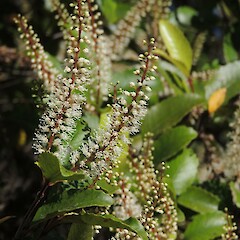Pterophylla racemosa
Common name
kāmahi, tawheo, tawhero, tawherowhero
Synonyms
Weinmannia racemosa L.f.
Family
Cunoniaceae
Flora category
Vascular – Native
Endemic taxon
Yes
Endemic genus
No
Endemic family
No
Structural class
Trees & Shrubs - Dicotyledons
NVS code
The National Vegetation Survey (NVS) Databank is a physical archive and electronic databank containing records of over 94,000 vegetation survey plots - including data from over 19,000 permanent plots. NVS maintains a standard set of species code abbreviations that correspond to standard scientific plant names from the Ngä Tipu o Aotearoa - New Zealand Plants database.
WEIRAC
Chromosome number
2n = 30
Current conservation status
The conservation status of all known New Zealand vascular plant taxa at the rank of species and below were reassessed in 2017 using the New Zealand Threat Classification System (NZTCS) – more information about this can be found on the NZTCS website. This report includes a statistical summary and brief notes on changes since 2012 and replaces all previous NZTCS lists for vascular plants.
Please note, threat classifications are often suggested by authors when publications fall between NZTCS assessment periods – an interim threat classification status has not been assessed by the NZTCS panel.
- Conservation status of New Zealand indigenous vascular plants, 2017 . 2018. Peter J. de Lange, Jeremy R. Rolfe, John W. Barkla, Shannel P. Courtney, Paul D. Champion, Leon R. Perrie, Sarah M. Beadel, Kerry A. Ford, Ilse Breitwieser, Ines Schönberger, Rowan Hindmarsh-Walls, Peter B. Heenan and Kate Ladley. Department of Conservation. Source: NZTCS and licensed by DOC for reuse under the Creative Commons Attribution 4.0 International licence.
2017 | Not Threatened
Previous conservation statuses
2012 | Not Threatened
2009 | Not Threatened
2004 | Not Threatened
Brief description
Tree to small shrub, young stems bearing deciduous stipules, leaves variable but as adults most simple, with deeply toothed margins, flowers white or pink, clustered in spike-like racemes
Distribution
Endemic. North Island, South Island and Stewart Island/Rakiura. The exact northern limits of Pterophylla racemosa are uncertain but probably lie somewhere along the Manukau Harbour and Hunua Ranges across the Kamai Range. North of here the distinction between P. racemosa and P. sylvicola is often confused. This needs further study.
Habitat
Coastal to subalpine. A widespread and common tree of disturbed habitats in coastal and lowland to montane forest, often becoming locally dominant in higher elevation montane forest in the higher ranges of the North Island and western South Island.
Wetland plant indicator status rating
Information derived from the revised national wetland plant list prepared to assist councils in delineating and monitoring wetlands (Clarkson et al., 2021 Manaaki Whenua – Landcare Research Contract Report LC3975 for Hawke’s Bay Regional Council). The national plant list categorises plants by the extent to which they are found in wetlands and not ‘drylands’. The indicator status ratings are OBL (obligate wetland), FACW (facultative wetland), FAC (facultative), FACU (facultative upland), and UPL (obligate upland). If you have suggestions for the Wetland Indicator Status Rating, please contact: [Enable JavaScript to view protected content]
FACU: Facultative Upland
Occasionally is a hydrophyte but usually occurs in uplands (non-wetlands).
Detailed description
Tree up to 28 m tall often forming a narrowly domed canopy (but this will vary according to local conditions). Trunk up to 1.2 m diameter. Branches numerous, erect to spreading, Foliage heterophyllous, with distinct seedling, juvenile and adult leaves (reversion shoots common). Stipules caducous, 3–6 mm long, lanceolate, finely pubescent, yellow-green to pinkish. Seedling and juvenile leaves membranous to subcoriaceous, 10–60 × 10–30 mm; lamina simple to 3-lobed or 3-foliolate, ovate-elliptic to elliptic or lanceolate, apices subacute to acute, margins serrate to incised-serrate; adult leaves coriaceous, on petioles up to 20 mm long, lamina 30–100 × 20–40 mm lamina simple, elliptic, ovate-elliptic to broad-ovate, apices obtuse to subacute, margins rather coarsely, bluntly serrate. Inflorescences racemose; racemes 60–140 mm long, rachises and pedicels finely, pilose-pubescent; pedicels 2–4 mm long, clustered, ascending to spreading. Sepals 1.0–1.5 mm. long, ovate, persistent. Petals 4–(5), 2–3 mm long, ovate-oblong, white, cream or pale pink. Stamens 8–10, exserted; filaments up 10 mm long, white or pinkish white; anthers 0.2–0.3 mm diameter, cream. Nectaries 8, red; ovary, narrowly ovoid 0.8 mm diameter, covered in appressed hairs, carpels 2, free almost to base. Pistils: styles 3–4 mm long, pale pink, persistent; stigma 0.2–0.4 mm, pink or pale pink, punctate. Fruit a pubescent, broadly cylindrical capsule 4.0–5.8 × 2.7–3.1 mm, initially greyish drying honey-brown or dark brown. Seeds numerous, 1.0–1.5 mm long, narrowly elliptic to elliptic-oblong, orange-brown, apices bearing dense hair tufts, otherwise glabrous.
Flowering
July–January
Flower colours
White
Fruiting
October–May
Propagation technique
Easily grown from fresh seed. Can also be grown from semi-hardwood cuttings. This is an attractive tree tolerant of a wide range of conditions and soil types though it does best in high light, and in free-draining soil. The flowers are very attractive to a range of insects and birds.
Etymology
racemosa: Raceme bearing
Attribution
Fact sheet prepared for NZPCN by P.J. de Lange (13 October 2012). Description prepared by P.J. de Lange.
References and further reading
McKenzie R. 1960. The distributional overlap of Weinmannia sylvicola and Weinmannia racemosa. Auckland Botanical Society Journal 17: 7–8.
NZPCN Fact Sheet citation
Please cite as: de Lange, P.J. (Year at time of access): Pterophylla racemosa Fact Sheet (content continuously updated). New Zealand Plant Conservation Network. https://www.nzpcn.org.nz/flora/species/pterophylla-racemosa/ (Date website was queried)





















